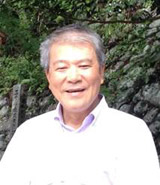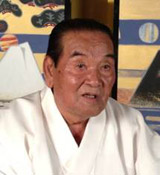
|
HOME > Gaia Symphony Official Guide > No.8 No.1 | No.2 | No.3 | No.4 | No.5 | No.6 | No.7 | No.8 | No.9 |
|||||||||
| Gaia Symphony No.8 |
|||||||||
| Can you sense the call from the Universe? ~Towards a new evolution of human civilization~ |
|||||||||
|
One might think that the Universe itself is determined that the life it gave birth to will absolutely continue as long as possible. And nothing on earth more embodies this “universal mind” than the tree. It is trees which have for billions of years maintained the earth’s atmosphere at an oxygen level of 21% (according to Gaia theory) and allowed destruction and evolution to be repeated thus supporting diverse forms of life. Within all world cultures, there are trees hundreds of years-old which are said to have a spirit or soul hidden within them. Perhaps it is this “tree spirit” which embodies the “universal mind.” For nearly 10,000 years from the remote Jomon age, the voices of the tree spirits have echoed in waves through the bodies of the Japanese people, and continue to do so today. It can likely be said that the beauty of Japan’s traditional culture, admired throughout the world, has been nurtured and refined through its relationship with the spirit of the tree. Three years after the Great Tohoku Earthquake and Tsunami, what is it that the Japanese people should be aware of and what is it they should do to achieve true rebirth and regeneration as they attempt to recover from the destruction and hardship brought on by a powerful cosmic force much greater than the human mind can comprehend? There are some Japanese who believe that “we must relearn the ability to listen to the voice of the tree spirit, in other words, the voice of the cosmos.” Gaia Symphony No. 8 will attempt to transmit to the world the thinking and activities of these people in hopes that all living things on earth will continue to live healthily. Key words : fear, beauty, wisdom and bravery Jin Tatsumura |
|||||||||
|
~ Encountering the Tree Spirit ~ Restoring the Noh Mask Akobu-jô (angry old man)
This noh mask, with the name Akobu-jô, was presented to the Tenkawa Shrine by the gifted noh actor and third Kanze school head, Motomasa, after he had with great emotion danced on the Shrine’s noh stage. Just one year later in 1432, it is said that Motomasa, while traveling in Ise, was for some unknown reason assassinated. In September 2011, a chance for this akobu-jô mask to once again appear on stage came about immediately after the Tenkawa Dai-Benzaiten Shrine had been seriously damaged in the torrential rains that pounded the Kii Peninsula. A request to use the mask came to the chief priest of the Shrine, Mikinosuke Kakisaka, from the National Noh Theatre in Tokyo which was preparing a new noh play called Zeami about Motomasa’s father. However, a noh mask from 600 years ago cannot suddenly be used on stage. Instead, the renowned mask-maker Yasuo Miichi was requested to start the process of restoration. A noh mask is not simply a mask to be used for the theater. The spirits of many potential noh masks, like the spirit of a tree itself, are hidden in the old tree which has been carefully selected to make the mask. The artisan, while learning the ancient mask forms, brings out the form of the mask to the world by refining his craft and through prayer. As if a ritual of the gods, with each stroke of the mask-maker’s chisel, the spirit of the tree is slowly revealed to the world. When the actor puts the mask on and stands on stage, he is possessed by the “universal mind” which extends beyond time and space into the world of yûgen, a concept in noh which suggests a mysterious, subtle and profound beauty. In “Restoring Akobu-jô,” we attempt to ask what the “true rebirth” is?
|
|||||||||
| |||||||||
|
~ Listening to the Voice of the Tree Spirit ~ ~A Stradivarius and a Tsunami Violin~
How have these “Strad” continued to last for 300 years as great performance violins? This is what Nakazawa says. On the day of the March 11th Earthquake and Tsunami, Nakazawa was in his Tokyo studio in the midst of repairing a Strad. In an instant, the work and life of people’s existence was destroyed by an unimaginable cosmic force. Dumbfounded, days of numbness followed as Nakazawa watched the scenes on television. One day a story was introduced on television from the city of Rikuzen Takada telling of a “miraculous pine tree” which survived the tsunami in the midst of a mountain of rubble from the wood of an old farm house which had been destroyed. Nakazawa’s violinist wife Kimiko saw this program and said the following to Nakazawa. “Dad—that isn’t just rubble. Those are pillars and beams of a house which have the memory of living together with people for many years. I wonder if you could use that wood together with that pine tree to make a new violin.”
| |||||||||
| |||||||||
|
~ Growing Trees with Heart ~ “ The forest is longing for the sea, The sea is longing for the forest”
Due to his reforestation activity known as “The forest longs for the sea” which exposed this situation with Hatakeyama’s perceptive eye, Kesennuma Bay gradually became blue again, and was even praised by a French oyster aquaculturalist who said, “This sea is heaven for oysters.” But with the March 11th tsunami, Kesennuma Bay was attacked and Hatakeyama’s oyster beds were completely destroyed. Losing his own beloved mother, Hatakeyama himself barely escaped to high ground with his own life while hugging a grandchild. His losses were over several hundred million yen as all living things in the sea disappeared. From that hopelessness, Hatakeyama said the following. “Both heaven and hell coexist in this sea. That is what nature is.” About a month after the great tsunami, one day Hatakeyama’s grandchild came running back from the sea and cried out, “Grandpa, there are a whole bunch of little fish swimming in the sea.” As a test, when Hatakeyama put a few remaining young oysters and scallops into the sea, they grew twice as fast compared to before the tsunami. Kesennuma Bay, under its own power had begun an astounding recovery. Why 25 years earlier was Hatakeyama able to notice that the destruction of the forests was the reason for the dirtying of the sea? The background to that is the gentle fusion of the Japanese view of nature passed down from the ancient Jomon period with the intellect of contemporary science. Seoritsu-hime, the goddess revered in the Murone Shrine on Mt. Murone, is a Jomon goddess which is said to purify the inevitable impurities of human life with the mountain’s river rapids, and then deliver healthy and fresh water to the sea. From childhood, Hatakeyama participated in this festival and must have unconsciously felt the bonds between the forest, the river and the sea. As a youth, he learned to manipulate the oars on his father’s Japanese-style boat and gained through his body the wisdom of sea people, and then later through contemporary science, came to understand scientifically the reasons for pollution of the sea. And that no doubt is what came to fruition in the “The forest longs for the sea ” activity. The Murone Shrine holds its Great Festival every four years. In this festival, the people of the sea collect sea water before dawn and carry it to the Murone Shrine to purify the goddess. Only after that does the festival begin. In 2013, the Great Festival was held for the first time after the Earthquake and Tsunami and Hatakeyama had a major role in the festival. The climax of the festival depicts Hatakeyama’s recovery of the soul and the recovery of the sea.
| |||||||||
| |||||||||
Shigeatsu Hatakeyama authored books: Children’s book: “The Oyster Grandpa and Shigebô” Published by Kodansha “A Travel Journal of Japan’s Brackish Water—Visiting the World of ‘The forest longs for the sea’” Published by Bungei Shunju “The forest longs for the sea” Published by Bungei Shunju | |||||||||
Copyright Jin Tatsumura Office |
|||||||||

 For the past 600 years, while waiting to once again see the light of day, a noh mask has lain hidden away in the treasure house of the Tenkawa Dai-Benzenten Shrine deep in the mountains of Yoshino in Nara Prefecture.
For the past 600 years, while waiting to once again see the light of day, a noh mask has lain hidden away in the treasure house of the Tenkawa Dai-Benzenten Shrine deep in the mountains of Yoshino in Nara Prefecture.


 In 17th century Italy, there was a gifted violin maker who was able to hear the voice of the “tree spirit.The famous string instruments known as “Strad” and crafted during the 90-year life of Antonio Stradivari have continued to be played and loved by the greatest musicians for over 300 years and are still coveted today by 21st century musicians.
In 17th century Italy, there was a gifted violin maker who was able to hear the voice of the “tree spirit.The famous string instruments known as “Strad” and crafted during the 90-year life of Antonio Stradivari have continued to be played and loved by the greatest musicians for over 300 years and are still coveted today by 21st century musicians.

 Hatakeyama began a movement to reforest Mt. Murone in 1989 after being the first to notice that the reason that the blue sea of Kesennuma Bay had begun turning red in the midst of Japan’s industrial growth period was due to the destruction of the forests on Mt. Murone.
Hatakeyama began a movement to reforest Mt. Murone in 1989 after being the first to notice that the reason that the blue sea of Kesennuma Bay had begun turning red in the midst of Japan’s industrial growth period was due to the destruction of the forests on Mt. Murone. 